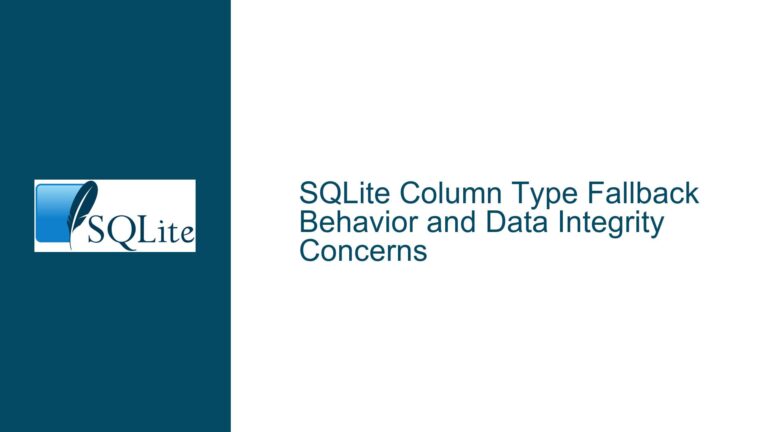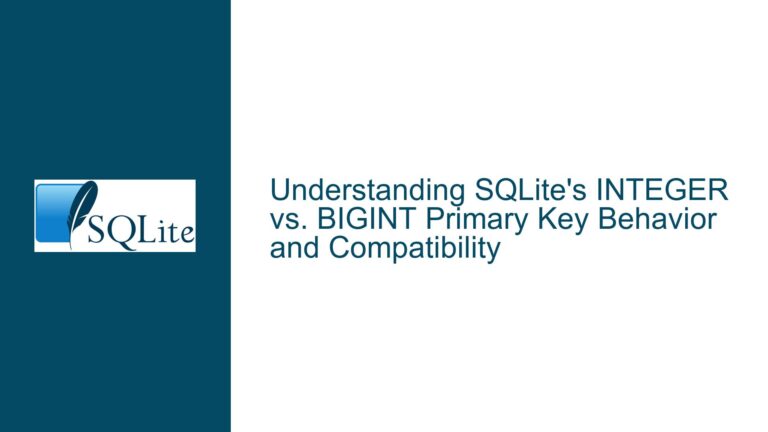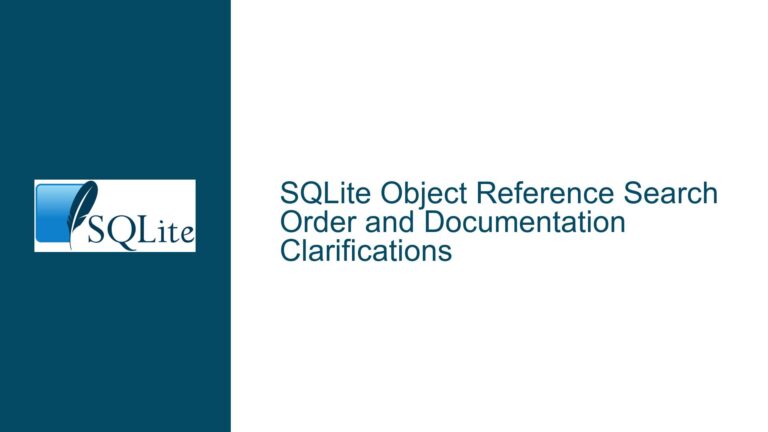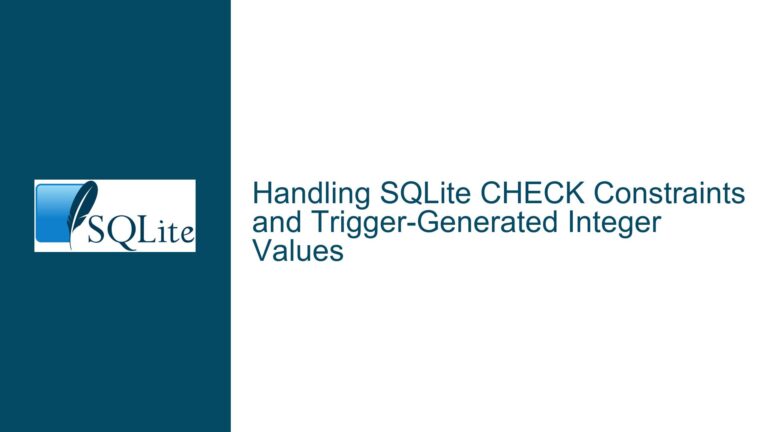Purging Dynamic Tables in SQLite While Preserving a Static Table
Identifying and Safely Removing Dynamic Tables in a Transactional SQLite Database
Issue Overview: Managing Dynamic Table Deletion with a Static Retention Requirement
In enterprise applications leveraging SQLite on Android devices, a common operational requirement involves maintaining a static table (e.g., Security) within a transactional database (e.g., Daily_Activities) while programmatically purging all dynamically created tables (e.g., orders_1, invoice_456, service_789) after synchronization. The challenge arises from the variable nature of these transactional tables, which are generated during daily operations with unpredictable naming conventions (e.g., sequential or context-specific suffixes). The core technical hurdle is automating the identification and deletion of all transient tables without affecting the static Security table or compromising database integrity. This process must be executed reliably through command-line interactions, as the application relies on external scripts or system calls to perform maintenance tasks.
The complexity of this task is compounded by several factors. First, SQLite lacks built-in commands to drop multiple tables using wildcards or pattern matching, necessitating a programmatic approach to enumerate and delete tables. Second, transactional databases often include schema dependencies, temporary indices, or triggers that must be accounted for during cleanup. Third, the static Security table may have referential integrity constraints or be involved in transactions with other tables, requiring careful isolation during deletion. Fourth, the dynamic table names (e.g., orders_1-xxxx) imply a naming convention that must be parsed accurately to avoid accidental retention or deletion of incorrect tables. Finally, the solution must operate within the constraints of Android’s environment, where direct filesystem access or privileged operations may be restricted.
Possible Causes: Architectural and Operational Factors Composing the Deletion Challenge
Monolithic Database Design: Combining static and dynamic tables within a single database (
Daily_Activities) creates entanglement where schema operations on transient tables risk collateral damage to persistent data. This design forces complex filtering during deletion instead of leveraging database-level isolation.Unstructured Dynamic Table Naming: Tables like
orders_1,orders_2, etc., follow a pattern that is predictable but not strictly enumerable. Without a centralized registry or metadata table tracking these dynamic entities, the application cannot directly map which tables to delete. This necessitates querying SQLite’s internal schema tables (e.g.,sqlite_schema) and applying filters, which can fail if the naming conventions are ambiguous or if non-transactional tables share similar prefixes.Lack of Schema Partitioning: The absence of attached databases or schema namespaces forces all tables to coexist in a single schema. If the static
Securitytable were moved to a separate database file, the transactional database could be reset entirely (e.g., by deleting and recreating the file) without affecting the static data. The current architecture’s reliance on a single database file complicates partial deletions.Transaction and Locking Conflicts: During the deletion process, open connections or pending transactions in the application may lock the database, preventing schema modifications like
DROP TABLE. This is especially problematic in Android, where multiple components (e.g., services, activities) might access the database concurrently.Foreign Key Constraints and Triggers: If dynamic tables reference the
Securitytable via foreign keys or are involved in triggers, direct deletion attempts may fail due to SQLite’s enforcement of referential integrity. Disabling foreign key checks (PRAGMA foreign_keys = OFF) or cascading deletions must be handled explicitly.File System Permissions and Integrity: On Android, the database file (
Daily_Activities) and its journaling files (e.g.,-wal,-shm) must be writable during deletion. File ownership, SELinux policies, or storage encryption might interfere with command-line operations called from the app.
Troubleshooting Steps, Solutions & Fixes: A Systematic Approach to Dynamic Table Management
Step 1: Decouple Static and Dynamic Data via Database Attachments
Objective: Isolate the Security table into a dedicated database to enable atomic resetting of transactional data.
Create a Separate Security Database:
Generate a new SQLite database file (e.g.,Security.db) containing only theSecuritytable. This file remains untouched during daily resets. Use theATTACH DATABASEcommand in the main application to linkSecurity.dbat runtime:ATTACH DATABASE '/path/to/Security.db' AS security_db;Queries referencing the
Securitytable must now use thesecurity_dbschema prefix:SELECT * FROM security_db.Security;Reconfigure the Transactional Database:
TheDaily_Activitiesdatabase now contains only dynamic tables. At the end of each day, the entire file can be deleted or replaced with a blank database, as theSecuritytable resides elsewhere. This eliminates the need for granular table deletion.Implementation via Command Line:
From the Android app, invoke shell commands to delete the transactional database file and reinitialize it:rm /path/to/Daily_Activities.db sqlite3 /path/to/Daily_Activities.db 'VACUUM;'The
VACUUMcommand creates a new, empty database if the file is missing. Ensure the app reattachesSecurity.dbon startup.
Step 2: Programmatic Identification and Deletion of Dynamic Tables
Objective: Dynamically generate DROP TABLE statements for all tables except Security when using a monolithic database.
Query SQLite’s Schema Table:
Extract the names of all user-defined tables fromsqlite_schema, excludingSecurityand SQLite system tables (e.g.,sqlite_sequence):SELECT name FROM sqlite_schema WHERE type = 'table' AND name NOT LIKE 'sqlite_%' AND name != 'Security';Generate and Execute
DROP TABLECommands:
In a shell script or using Android’sRuntime.exec(), pipe the output of the schema query intoDROP TABLEstatements. For example, using thesqlite3command-line tool:sqlite3 /path/to/Daily_Activities.db <<EOF .mode list .once drop_tables.sql SELECT 'DROP TABLE IF EXISTS "' || name || '";' FROM sqlite_schema WHERE type = 'table' AND name NOT LIKE 'sqlite_%' AND name != 'Security'; .read drop_tables.sql EOFThis script creates a temporary file (
drop_tables.sql) containing all necessaryDROP TABLEcommands and executes them in sequence.Handle Foreign Key Constraints:
Disable foreign key enforcement before deletion to prevent errors from tables referencingSecurity:PRAGMA foreign_keys = OFF; -- Execute DROP TABLE statements here PRAGMA foreign_keys = ON;
Step 3: Atomic Database Reset with Transaction Safeguards
Objective: Ensure table deletions are atomic and recoverable, avoiding partial execution states.
Wrap Deletions in a Transaction:
Use a transaction to guarantee that either all dynamic tables are deleted or none, preserving consistency:BEGIN TRANSACTION; PRAGMA foreign_keys = OFF; -- Generated DROP TABLE statements PRAGMA foreign_keys = ON; COMMIT;Logging and Error Handling:
Capture the output of command-line operations to detect failures. For example, in a shell script:if ! sqlite3 Daily_Activities.db < script.sql; then echo "Deletion failed. Rolling back changes..." >&2 exit 1 fiVACUUM After Deletion:
Reclaim storage space and defragment the database file post-deletion:VACUUM;
Step 4: Alternative Approach – In-Memory Databases for Transactional Data
Objective: Leverage SQLite’s in-memory databases to avoid persistent storage of dynamic tables.
Store Dynamic Tables in Memory:
Initialize the transactional database as:memory:at the start of each day. Since in-memory databases are volatile, they automatically reset when the application restarts. TheSecuritytable remains in a persistent attached database.// Android example: Initialize in-memory database SQLiteDatabase db = SQLiteDatabase.create(null); // null = in-memorySynchronization Before Shutdown:
Ensure all transactional data is synced with the server before the app terminates or the database connection closes. This approach eliminates the need for manual table deletion but requires stable network connectivity.
Step 5: Schema Metadata Triggers for Dynamic Table Tracking
Objective: Automatically register dynamic tables in a metadata table for precise deletion.
Create a Registry Table:
Add a tabledynamic_tablesto track the names and creation timestamps of dynamic tables:CREATE TABLE IF NOT EXISTS dynamic_tables ( id INTEGER PRIMARY KEY, table_name TEXT UNIQUE, created_at DATETIME DEFAULT CURRENT_TIMESTAMP );Trigger on Table Creation:
Use aCREATE TABLEtrigger to populatedynamic_tableswhenever a new transactional table is generated:CREATE TRIGGER register_dynamic_table AFTER CREATE ON Daily_Activities BEGIN INSERT INTO dynamic_tables (table_name) VALUES (NEW.name); END;Batch Deletion Using Registry:
At cleanup time, querydynamic_tablesfor all tables created during the day and execute batch deletions:SELECT 'DROP TABLE IF EXISTS "' || table_name || '";' FROM dynamic_tables WHERE created_at >= date('now', 'start of day');
Final Considerations: Performance, Security, and Testing
Performance: Attaching multiple databases incurs a slight overhead. Benchmark the application with attached databases versus monolithic designs under load.
Security: Ensure
Security.dbis encrypted if it contains sensitive information, using SQLite’s Encryption Extension (SEE) or Android’s built-in SQLiteCipher.Testing: Validate table deletion scripts using Android emulators or rooted devices to capture low-level filesystem errors. Test scenarios include interrupted deletions, concurrent database access, and invalid dynamic table names.






